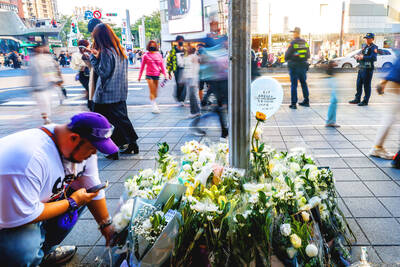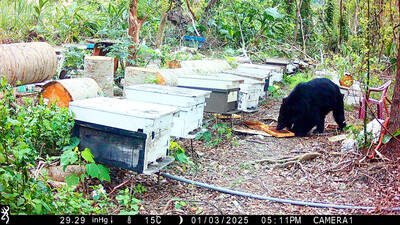The Mainland Affairs Council urged China to face the reality that both sides of the Taiwan Strait have been under separate rule for the past 67 years.
The council was responding to remarks made by Chinese Premier Li Keqiang (李克強), who on Thursday said that both sides of the Taiwan Strait belong to “one China,” adding that it is a fact that cannot be changed.
Li and former vice president Vincent Siew (蕭萬長) met on the sidelines of the Boao Forum for Asia in China’s Hainan Province, with Li saying that cross-strait relations would not change because a party that is known for its pro-Taiwanese independence stance is taking over as the nation’s ruling party.
Li said that China plans to continue peaceful development of bilateral ties based on the “political foundation of the [so-called] 1992 consensus.”
The council said that the “1992 consensus,” which has served as the basis for institutionalized negotiations and exchanges between the two sides over the past eight years, highlights the sovereignty of the Republic of China (ROC).
Li said the fruitful results from years of peaceful development of cross-strait ties were ample proof that maintaining the foundations of the “1992 consensus” would be a good way to create a bright future for both sides.
Not only can such a foundation maintain peace across the Strait, but it can also create benefits for people on both sides, he told Siew.
“The government has been insisting on defining cross-strait relations in accordance with the ROC Constitution,” the council said, urging China to respect and understand the opinion and feelings of Taiwanese.
Saying that “maintaining benevolent cross-strait interactions is the common responsibility of both sides,” the council said that Taiwan and China should have the wisdom to show good will to each other and engage in practical cooperation to create long-lasting peace and stability across the Strait.
The “1992 consensus” refers to a supposed understanding reached during cross-strait talks in 1992 that both Taiwan and China acknowledge that there is “one China,” with each side having its own interpretation of what “China” means.
Former KMT lawmaker Su Chi (蘇起) in 2006 admitted he made up the term in 2000, when he was head of the council, before the Chinese Nationalist Party (KMT) handed power to the Democratic Progressive Party.

SHIPS, TRAINS AND AUTOMOBILES: The ministry has announced changes to varied transportation industries taking effect soon, with a number of effects for passengers Beginning next month, the post office is canceling signature upon delivery and written inquiry services for international registered small packets in accordance with the new policy of the Universal Postal Union, the Ministry of Transportation and Communications said yesterday. The new policy does not apply to packets that are to be delivered to China, the ministry said. Senders of international registered small packets would receive a NT$10 rebate on postage if the packets are sent from Jan. 1 to March 31, it added. The ministry said that three other policies are also scheduled to take effect next month. International cruise ship operators

NUMBERS IMBALANCE: More than 4 million Taiwanese have visited China this year, while only about half a million Chinese have visited here Beijing has yet to respond to Taiwan’s requests for negotiation over matters related to the recovery of cross-strait tourism, the Tourism Administration said yesterday. Taiwan’s tourism authority issued the statement after Chinese-language daily the China Times reported yesterday that the government’s policy of banning group tours to China does not stop Taiwanese from visiting the country. As of October, more than 4.2 million had traveled to China this year, exceeding last year. Beijing estimated the number of Taiwanese tourists in China could reach 4.5 million this year. By contrast, only 500,000 Chinese tourists are expected in Taiwan, the report said. The report

HORROR STORIES: One victim recounted not realizing they had been stabbed and seeing people bleeding, while another recalled breaking down in tears after fleeing A man on Friday died after he tried to fight the knife-wielding suspect who went on a stabbing spree near two of Taipei’s busiest metro stations, Taipei Mayor Chiang Wan-an (蔣萬安) said. The 57-year-old man, identified by his family name, Yu (余), encountered the suspect at Exit M7 of Taipei Main Station and immediately tried to stop him, but was fatally wounded and later died, Chiang said, calling the incident “heartbreaking.” Yu’s family would receive at least NT$5 million (US$158,584) in compensation through the Taipei Rapid Transit Corp’s (TRTC) insurance coverage, he said after convening an emergency security response meeting yesterday morning. National

The Forestry and Nature Conservation Agency yesterday launched a gift box to market honey “certified by a Formosan black bear” in appreciation of a beekeeper’s amicable interaction with a honey-thieving bear. Beekeeper Chih Ming-chen (池明鎮) in January inspected his bee farm in Hualien County’s Jhuosi Township (卓溪) and found that more than 20 beehives had been destroyed and many hives were eaten, with bear droppings and paw prints near the destroyed hives, the agency said. Chih returned to the farm to move the remaining beehives away that evening when he encountered a Formosan black bear only 20m away, the agency said. The bear